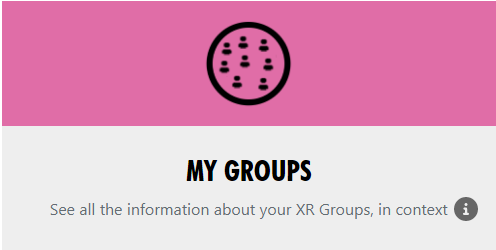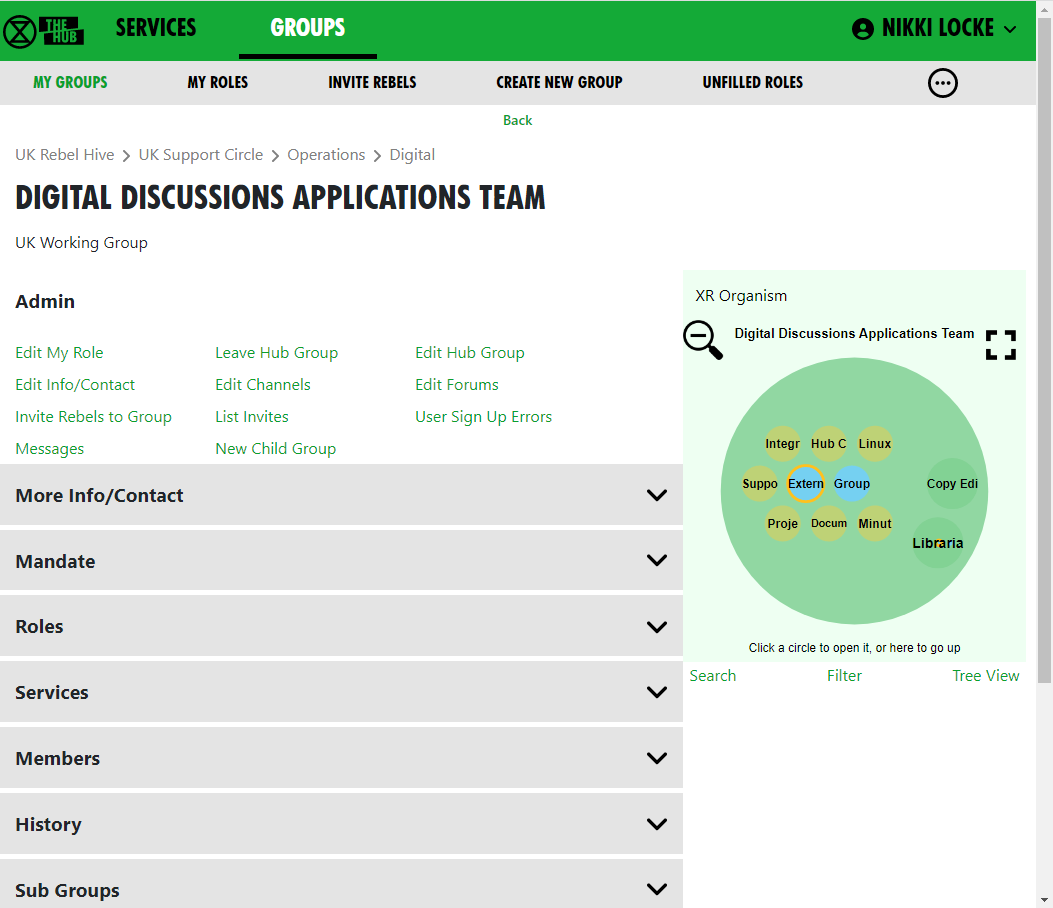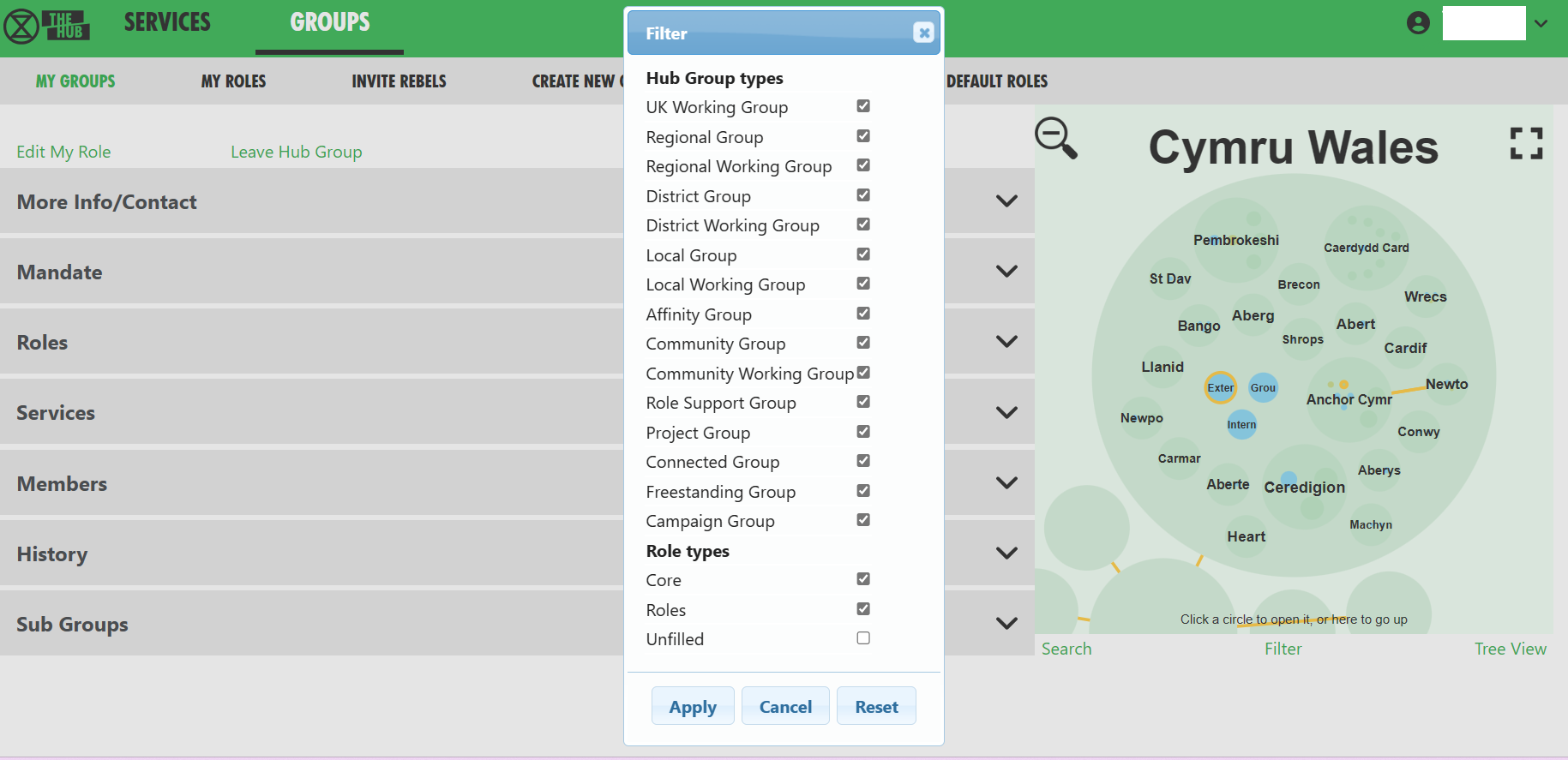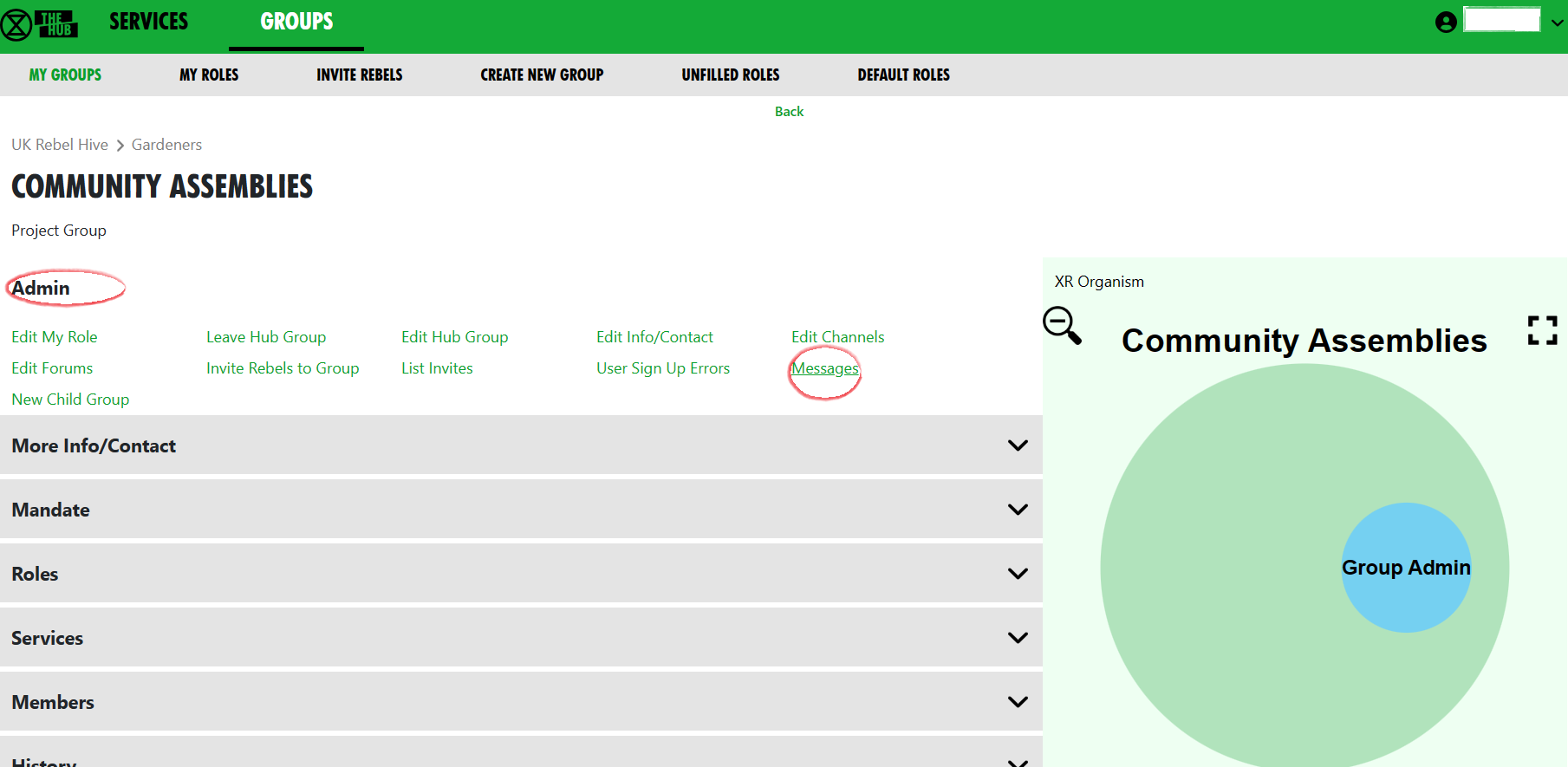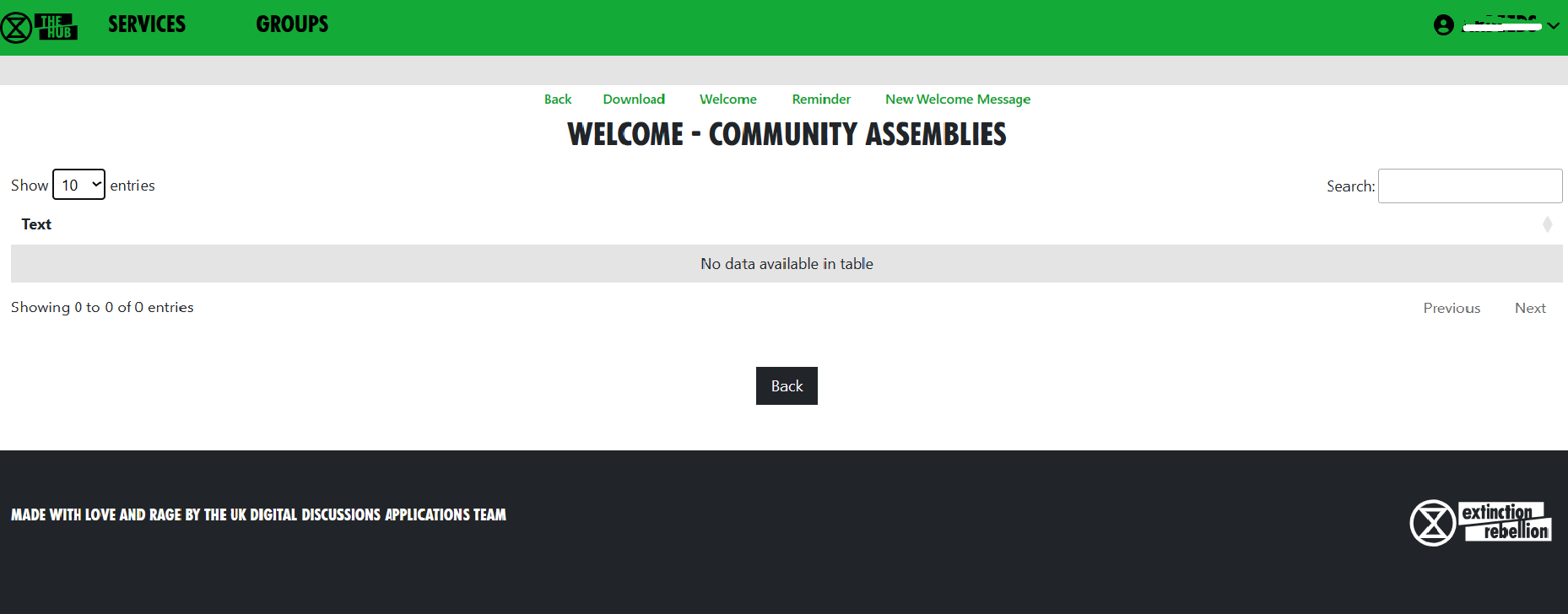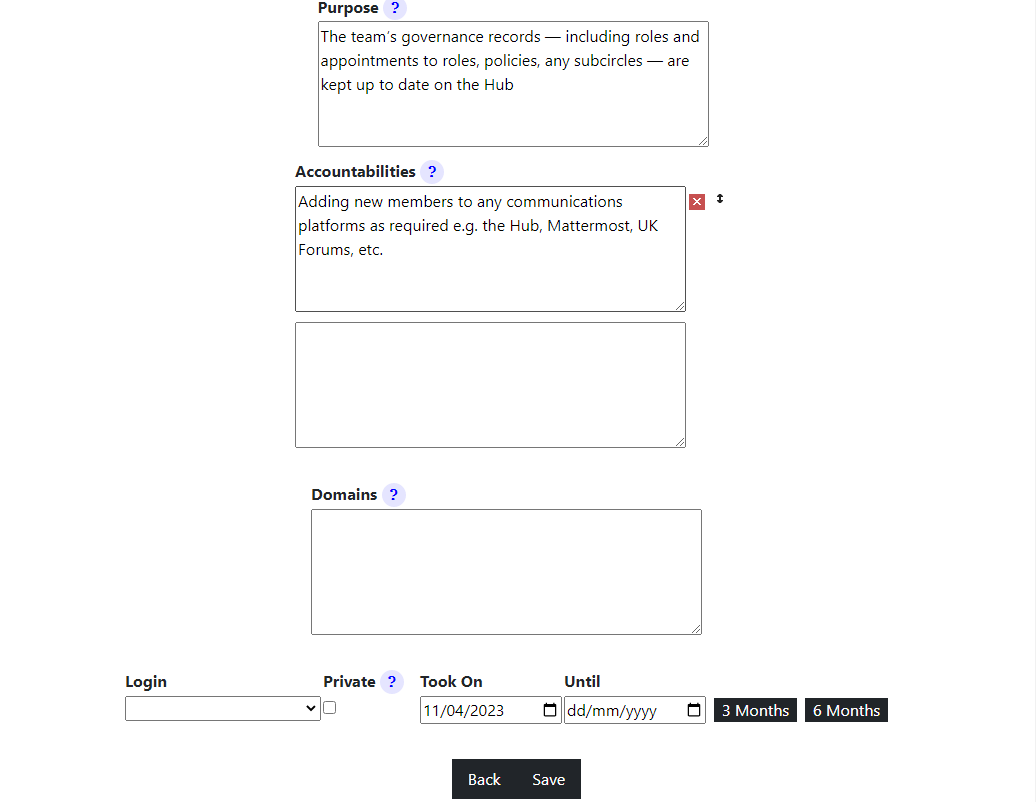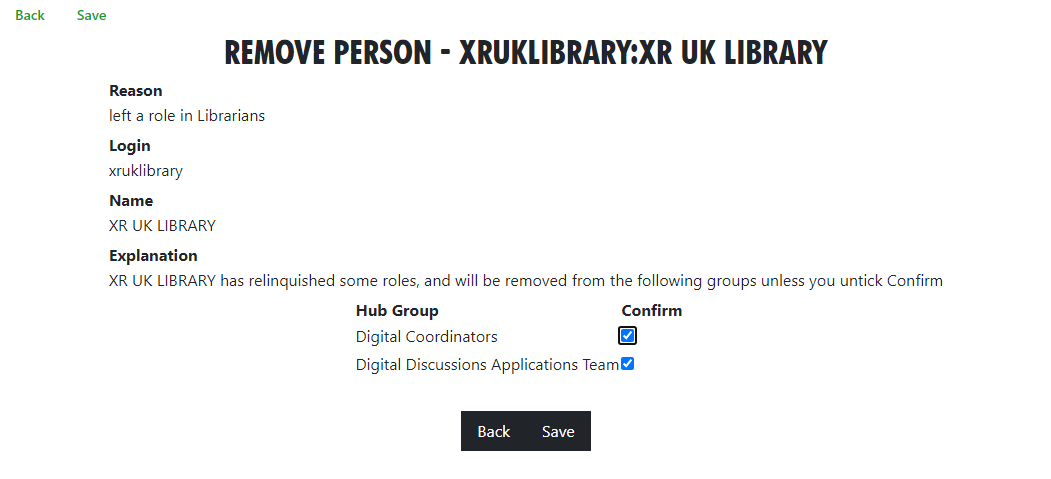XR Groups, Roles and Mandates
Read this guide to learn how to use the Hub to manage your group's mandates, roles, members, etc.
XR Groups Screen
If you click 'My Groups' on the Home page, you will see a screen like this:
[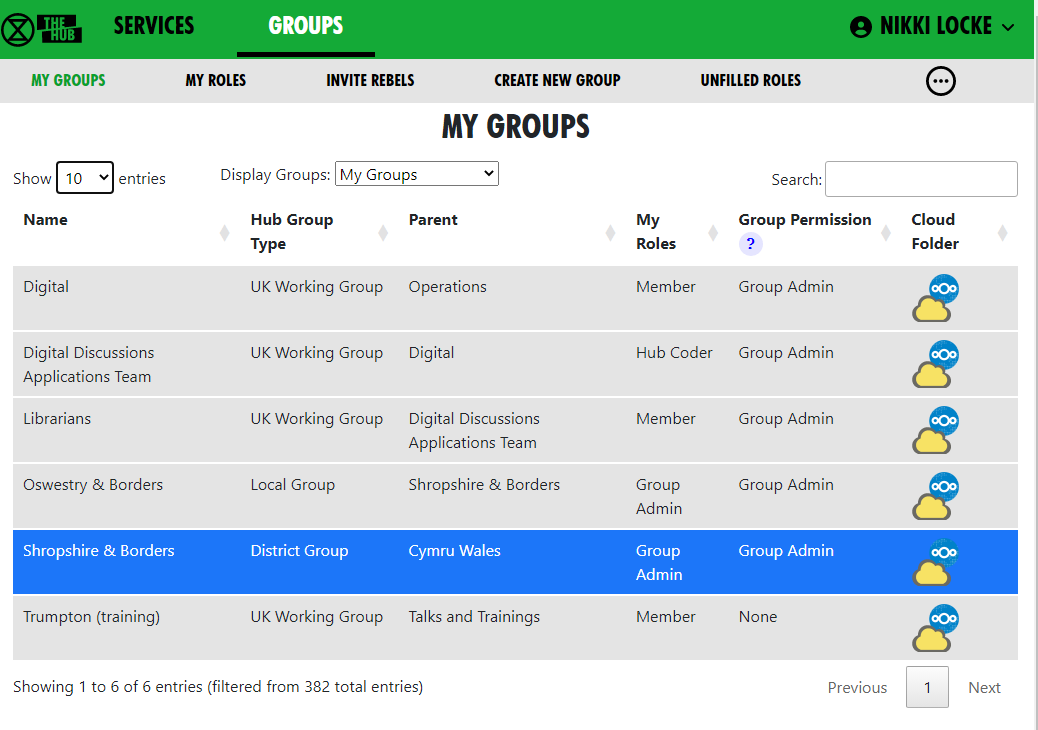 ](https://rebeltoolkit.extinctionrebellion.uk/uploads/images/gallery/2023-04/image-1681220533358.png)
](https://rebeltoolkit.extinctionrebellion.uk/uploads/images/gallery/2023-04/image-1681220533358.png)
Choose a group to see all its details in context.
This is the Group Admin view – ordinary users can see this screen, but won’t have the links to change things.
If you want to become a Group Admin for a group in order to be able to edit here, you will need to contact your Internal Coordinator (IC) / External Coordinator (EC) or an existing Group Admin who is listed for your group.
This page shows the group in context. You can click on any of the group names to see its parent and children groups. You can click on the dropdowns to see more information.
Each group is displayed the same way. Public links are always clickable. If you are a member of the group, the private links are clickable too. If you are a Group Admin, the extra admin links also appear.
The graphic display shows the group in context – you can click the full screen icon (the black 4 x corners making a square, top right) to make it bigger.
You can click on groups within this view to shift your view to display a different group. To come back out from that group and back into the bigger framework of groups, use the spyglass icon, top left.
Structure To find your way about XRUK, you can click on any group name on the screen to show that group, with its parent and children groups. Alternatively, you can click on a group in the Hub Circles XR Organism graphic display at the top right of the image above. This has a full screen button (the 4 x corners making a square, top right) to make it larger and easier to navigate.
If you are using the Hub Circles display, you can click the Filter link text below the graphic (in green font). This will hide some of the detail, to make the diagram less busy. If you set a filter, it is remembered, and used every time you open this view.
Here is an illustration of what the filter function brings up for someone looking at the Cymru Circle:
Don't be afraid of playing around with your options to filter here! Just remember that the filter stays in place for any future visit to this screen, so you might want to revert back to the full picture, with no filters before leaving the page!
XR Organism
To describe our XR UK organisational structure, we are on: organism.extinctionrebellion.uk. This is a public view updated from the Hub every night.
How To Find a Person to Contact Them on Mattermost
Click the grey 'Roles' band to open up a drop down of further detail. If you click the name of someone you wish to contact, you will automatically have a new tab opened that will take you to a direct messaging thread with that person on Mattermost.
How to Change People's Roles in your Group
All roles all have a 'shelf-life', called a tenure, i.e. they have a pre-arranged end date, agreed with the person stepping into a role. Having an end or review date will allow for new people to step forward to take on responsibilities and allow for life-changes for those in the role. This helps to mitigate for power. When someone's role reaches its end point, in order for people searching to find contacts for your group, (usually) the IC, or the Admin, for the Group will edit contact names and details.
The 'Roles' dropdown lets you view/edit the Roles within your group. Alternatively, you can click on an individual role in the display to edit it. See Edit Role screen below. The Roles dropdown view will show who is in the Core Roles and any sub-groups of that circle.
How to Change Your Group's Mandate
The 'Mandate' dropdown will show the group's Mandate. If you are Group Admin of the parent group, you will see an edit pencil button that will let you change the mandate.
To edit the Mandate:
- First ensure the parent circle has agreed the changes
- Select Mandate dropdown
- Click the edit pencil
- Make changes
- Save
The XR UK constitution says that all working groups should have a Mandate. However, not all parts of XR UK are covered by the constitution. Some Hub Groups were created without one. To make it clear when a group does not have to follow the constitution, we use different names:
| If the group follows the constitution | If it doesn't |
|---|---|
| Mandate | Scope |
| Role | Position |
| Purpose | What this group is for |
| Accountability | Activity |
| Domain | Resource |
The Mandate/Scope sections include:
- Purpose/What this group is for
- Accountabilities/Activities
- Domains/Resources
- Policies (optional section)
As a guide to completing the Mandate, you might research those of similar Groups in your region, or UK wide (Working Groups and Circles). Such existing Mandates may assist with arriving at your own wording.
See Rebel Toolkit guidance here: Mandates and How to Write Them.
How to See Changes Made to Roles, Members, Mandates
The 'History' link will show all changes made to roles and mandates over time. If you are viewing a role or mandate, it will just show the history of that item.
How to See People In My Group
The 'Members' dropdown shows you a list of everyone. Here you can set their roles, make them Group Admins or turn Group Admin status off. From there, you can click 'All Roles' to see all the roles that person has. From here you can click 'Step Back From Roles' to pass those roles on to someone else.
If you remove someone from one or more roles which are linked to another group, and that is the only role they hold in that group, you will see another screen where you can confirm whether or not they should also be removed from the other group.
An example of this might be an External Coordinator (EC) who is in a 'link role' to the Parent Circle. There may also be a link role from one group to another, e.g. Facilitation has a link role to XR UK Talks and Training.
How to Change My Role
'Edit My Role' in the Admin section lets you edit your own role in the group. Everyone in your group can edit their own role.
Note that only Group Admins can assign people to roles.
For more about core roles see the XR UK constitution.
Edit Messages Screen
How to Create / Change Semi-Automated Welcome Messages
To add/edit messages click the 'Messages' link in the Admin section.
See the Hub window above for your Admin options in green font. Here you will see the option for 'Messages' (Circled red). Click this to create a new message. From here you can either welcome new members with a friendly Direct Message in Mattermost, or you can send Reminder messages to others already in the group to remind or inform them of e.g. of meetings, trainings, newsletter deadlines, etc.
By way of example, see the image below. This is the Community Assemblies project team, who want to send a Welcome message.
Click on 'New Welcome Message', highlighted in yellow showing at the top of this next screen.
[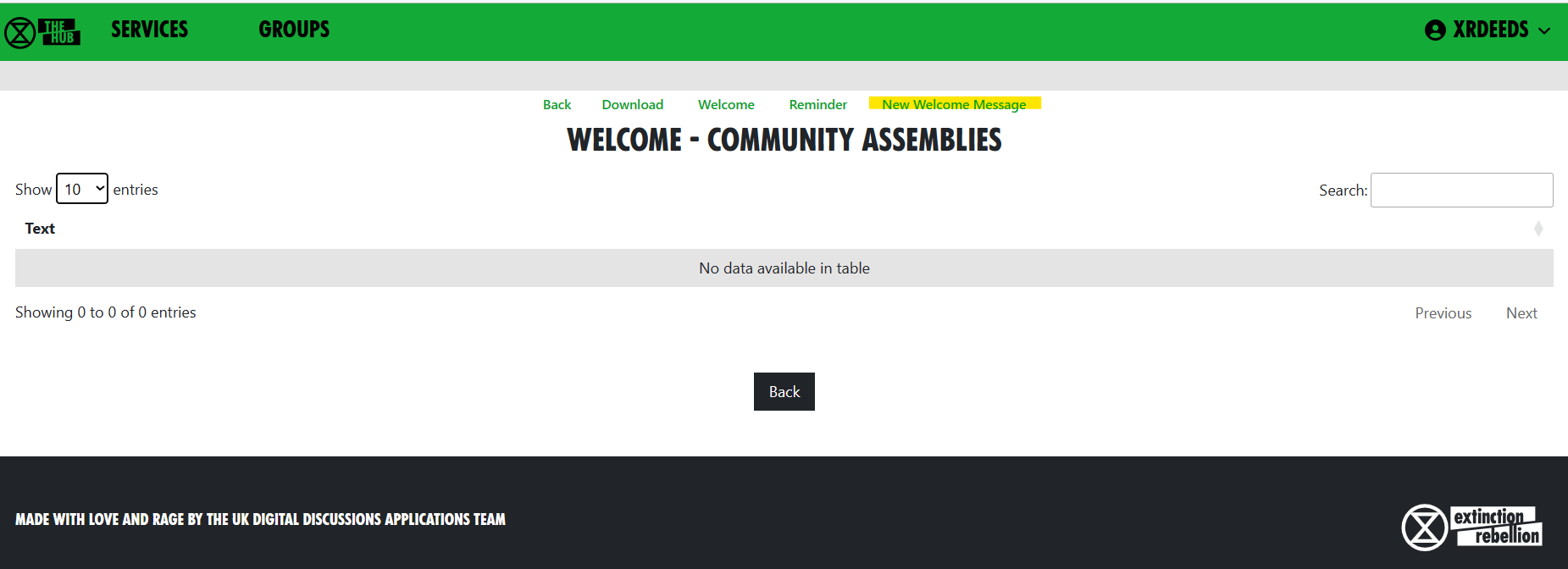 ](https://rebeltoolkit.extinctionrebellion.uk/uploads/images/gallery/2023-06/image-1687530776970.png)
](https://rebeltoolkit.extinctionrebellion.uk/uploads/images/gallery/2023-06/image-1687530776970.png)
Welcome messages are sent via Mattermost in a Direct Message to people who have just joined your group on the Hub. They come from xrukadmin (the Hub's Mattermost login/handle), which does not read replies. As recipients of a welcome message cannot reply, we recommend you include instructions for them to contact your own Mattermost handle in the message. E.g. "Please do not reply to this message, as it will not be responded to. Instead, please contact @fred-xrtrumpton if you have any questions".
Just enter the message text (you can use Markdown (simple coding) formatting, (as you can in Mattermost, Forums and Cloud), and click Save. Subsequently, anyone who accepts an invite to your organisation will receive that message overnight (as the Hub runs updates in the early hours of the morning.)
How to Set Reminder Messages
Reminder messages are useful for regular events (like a weekly meeting). They are posted to your channel of choice on Mattermost, by xrukadmin (the Hub's Mattermost login) each night.
Edit Role Screen
When a new group is created on the Hub, it gets a set of 3 standard roles:
- Internal Coordinator
- External Coordinator
- Group Admin.
There are an additional 8 roles, suggested by the Self Organising Systems Circle, which may be selected by the Group Admin when adding new Roles to the original set.
To add a new role for your group, click the  icon, then insert the role name you require.
icon, then insert the role name you require.
As you type, you are offered any Default Roles which match the input text; if you then select a Default Role, the form is prefilled with the details (including mandate) of that role - which can then be edited, if necessary.
This is just to save typing, and will help any Group Admin who may not know the exact wording of the Mandate for the desired Default Role. Note that any new Role will have a blank Mandate - i.e. Purpose and Accountabilities - which may be completed at a later time.
[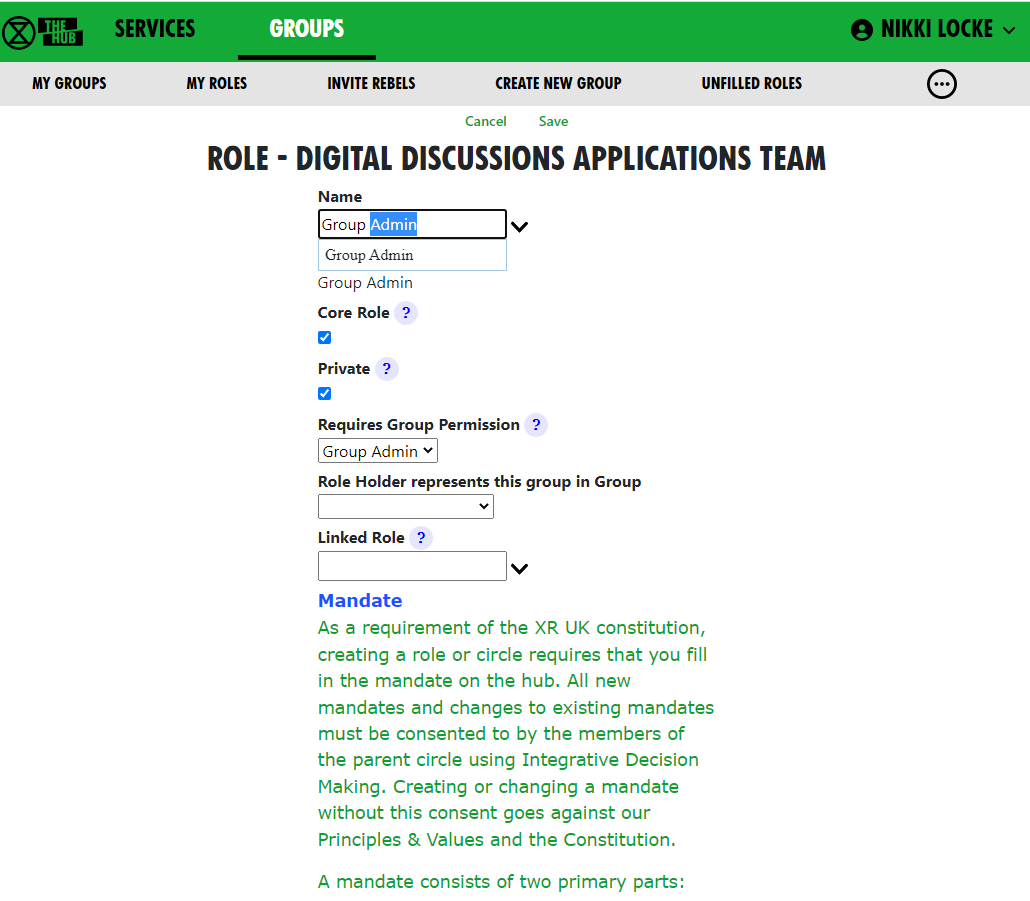 ](https://rebeltoolkit.extinctionrebellion.uk/uploads/images/gallery/2023-04/image-1681221401436.png)
Ticking Core Role shows the role in blue instead of green in the diagram, and prevents users from assigning themselves to that role (only Group Admins can assign people to Core Roles).
](https://rebeltoolkit.extinctionrebellion.uk/uploads/images/gallery/2023-04/image-1681221401436.png)
Ticking Core Role shows the role in blue instead of green in the diagram, and prevents users from assigning themselves to that role (only Group Admins can assign people to Core Roles).
The Private setting is the default for the role. If this is ticked, then users will have Private ticked by default. This can be changed by you or them.
Selecting a permission from the Requires Group Permission dropdown means that people assigned to this role automatically get that permission for this group, so they can invite people (Inviter), or edit roles, channels, forums, etc. (Group Admin).
You can add Accountabilities, or drag them using the handle to reorder them, or delete them with the red x button.
You can add Domains or delete them with the red x button.
Setting/Changing a Role Holder
You can place users in their role by selecting their names from the drop-down 'Roles' list. With admin permissions, you may also remove them by clicking the red ‘X’ next to their name. The 'Private' setting by each user should be ticked if the user does not want anyone outside the group to see that they hold this role.
You can set an 'Until' date for each person assigned to a role. This is the date their holding of that role will be reviewed. This allows people assigned to a role for a limited time to be confident that they won’t be left holding that role forever. Roles where the 'Until' date has passed will show in red on the group diagram.
Linking a Role to Another Group
You can link a role to another group. Then, when people join that role, they are automatically joined to a linked role in the other group. Usually, you will do this for the External Coordinator (EC) role; the EC of a working group or circle automatically joins the parent group as the sub-group’s representative. However, it doesn’t have to be the parent group; for example, in the past, Cymru Wales had a "Local Group Coordinators" group, that all their local group coordinators joined.
The only limitation on editing information in this regard is that you have to be a Group Admin of both groups, i.e.: parent and child.
To link a role, choose the group you want to link to in the Role Holder represents this group in Group dropdown.
Then either select an existing role in that group from the Linked Role dropdown, or type in a new role name if the new role will be created in the other group.
Normally a Group Admin of one group will create a child group, which automatically makes them Group Admin of the child group. They will then link the External Coordinator role in the child group to the parent group. They may well also appoint other Group Admins of the child group, then may remove themselves from the child group when this has been done. So just because they set up this administrative work does not mean to say they will continue in administering that group; they may hand to new Admins.
If nobody is Group Admin of both groups, Coordinators or Group Admins of both groups will have to ask a Hub Admin to do this task for you. If you don't know a Hub Admin, ask in Hub Help Desk on Mattermost.
If you remove people from a role which is linked to another group, and that is the only role they hold in that group, you will see another screen where you can confirm whether or not they should also be removed from the other group.
What Happens When a Role Allows Access to More Than One Hub Group?
When someone does one of the following things:
- Edits the Auto Join Roles screen (Hub Admins only)
- Edits the people in a role
- Edits the roles a person is in (+)
- Deletes a role
- Steps a person back from a role (+)
- Creates a group
- Deletes a group
- Admin edits a group (Hub Admins only)
- Removes someone from a group (+)
The change could entitle some people to be in different Hub Groups, e.g. if they join or leave a linked role, or a role with a support group.
The joining or inviting happen automatically, but any groups they should probably be removed from are first listed in a screen with tickboxes against each one, so the person making the change has a chance to untick people they do not want to be removed.
The removal screen is simpler in these cases, because only a single person is affected, so it just shows a list of groups the person could be removed from. In the other cases, it has to show both person and group, as there is no reason why the same person might not be joined to two or more groups. For example: all the Cymru Group Admins will be joined to the UK level Group Admins group, as well as the Cymru one.
Here's the more complicated screen:
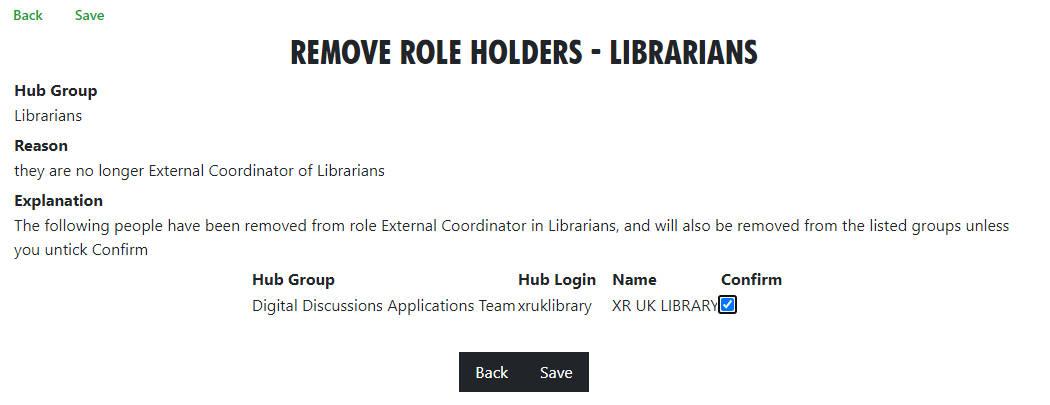
Please click 'Save' in this screen to carry out the removals. If you think a person should not be removed, first untick the corresponding 'Confirm' box.
Step Back From Roles Screen
You reach this screen by finding a person with a role in 'All Members', clicking on 'All Roles', then clicking on 'Step Back From Roles'.
[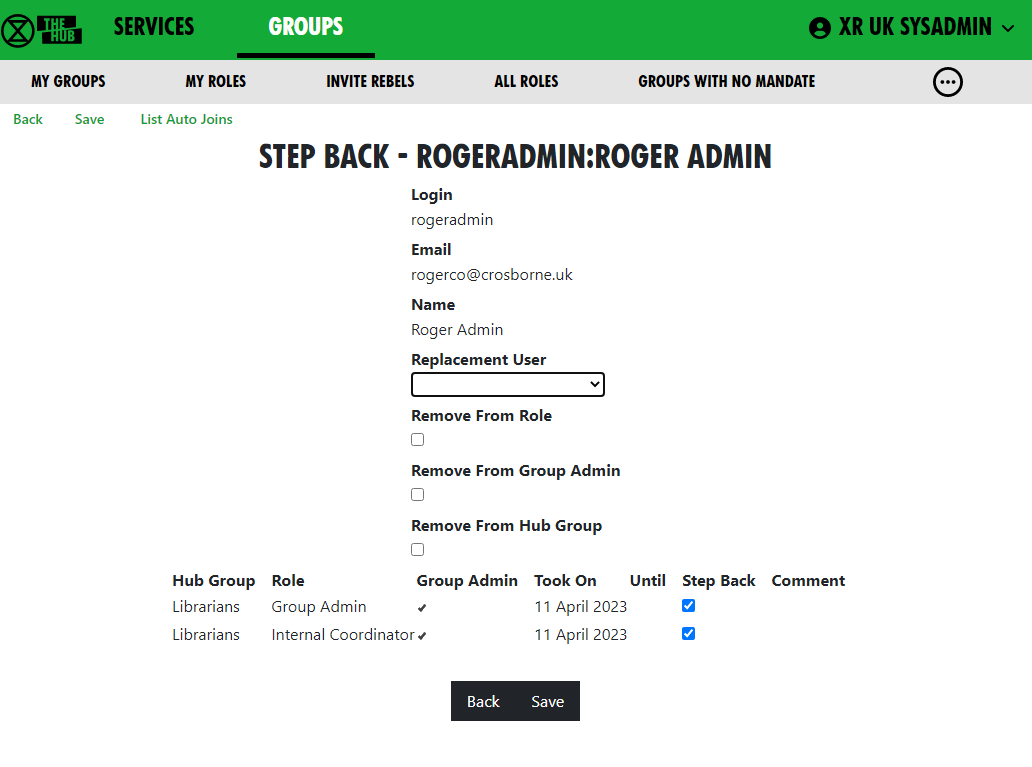 ](https://rebeltoolkit.extinctionrebellion.uk/uploads/images/gallery/2023-04/image-1681222397597.png)
If you choose a replacement user from the dropdown, that person will be assigned to all the roles with Process ticked (being joined to the organisation if they are not already in it).
](https://rebeltoolkit.extinctionrebellion.uk/uploads/images/gallery/2023-04/image-1681222397597.png)
If you choose a replacement user from the dropdown, that person will be assigned to all the roles with Process ticked (being joined to the organisation if they are not already in it).
If you check Remove From Role, the original person will be removed from the roles with 'Step Back' ticked.
If you check 'Remove From Group', the original person will be removed from all groups with 'Step Back' ticked.
If you remove someone from one or more roles which are linked to another group and that is the only role they hold in that group, you will see another screen where you can confirm whether or not they should also be removed from the other group.
So, for example:
| Change Required | Action |
|---|---|
| Join a new person to the roles, to be trained by the original person | Select the new person in 'Replacement User'. Leave 'Remove From' boxes unticked. Tick all the roles you want them to be added to and untick the others. |
| Pass the roles on to someone else because the original user has already stepped back. | Select new person in 'Replacement User'. Tick 'Remove From Role'. Tick all the roles they are stepping back from and untick the others. If the person has left the group(s) altogether, rather than just stepped back from the role to become an ordinary member, also tick 'Remove From Group'. |
| Step someone back from their roles, without appointing anyone else | Leave 'Replacement User' blank. Tick 'Remove From Role'. Tick all the roles they are stepping back from and untick the others. If the person has left the group(s) altogether, rather than just stepped back from the role to become an ordinary member, also tick Remove From Group. |

